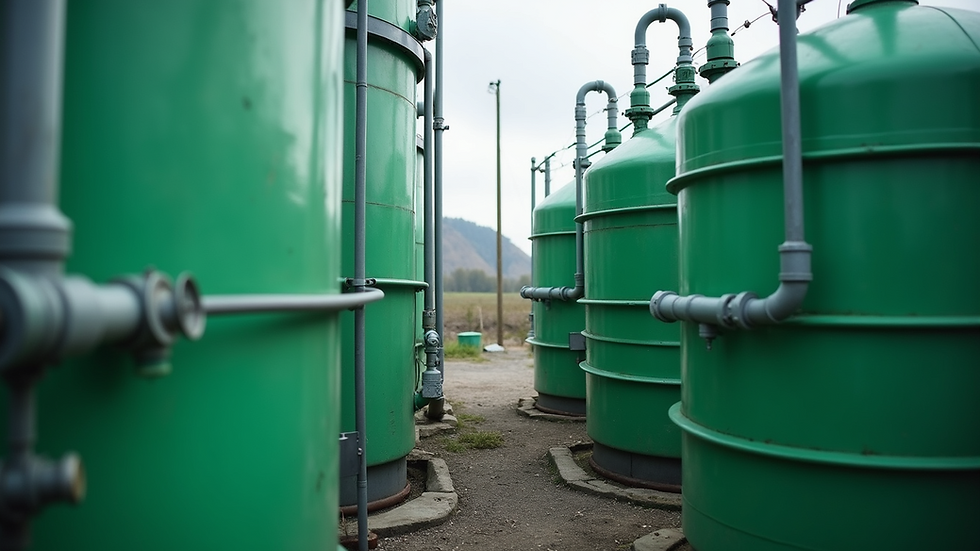Reducing Greenhouse Gas Emissions with Biogas Technology
- sid0194
- Sep 27
- 4 min read
In today's world, the urgency to combat climate change has never been greater. One of the most promising solutions lies in biogas technology. This innovative approach not only helps reduce greenhouse gas emissions but also provides a sustainable energy source. In this blog post, we will explore how biogas technology works, its benefits, and real-world examples of its implementation.
Biogas is produced through the anaerobic digestion of organic materials. This process occurs when microorganisms break down organic matter in the absence of oxygen. The result is a mixture of gases, primarily methane and carbon dioxide. Methane is a potent energy source, while carbon dioxide, although less harmful, still contributes to greenhouse gas emissions.
The beauty of biogas technology is that it can utilize a variety of organic materials. These include agricultural waste, food scraps, and even sewage. By converting these materials into energy, we can significantly reduce the amount of waste that ends up in landfills. This not only cuts down on methane emissions from decomposing waste but also provides a renewable energy source.
How Biogas Technology Works
Biogas technology involves several key steps:
Collection of Organic Material: The first step is gathering organic waste. This can come from farms, restaurants, or municipal waste facilities.
Anaerobic Digestion: The collected material is placed in a digester, where it is broken down by microorganisms. This process can take several weeks.
Biogas Production: As the organic material decomposes, biogas is produced. This gas can be captured and stored for later use.
Energy Generation: The captured biogas can be used to generate electricity or heat. It can also be upgraded to biomethane, which can be injected into the natural gas grid or used as vehicle fuel.
Digestate Management: After digestion, the remaining material, known as digestate, can be used as a nutrient-rich fertilizer, closing the loop in the waste cycle.
This process not only generates energy but also reduces the reliance on fossil fuels, making it a win-win solution for the environment.
Benefits of Biogas Technology
Biogas technology offers numerous benefits, including:
Reduction of Greenhouse Gas Emissions: By diverting organic waste from landfills, biogas technology significantly lowers methane emissions.
Renewable Energy Source: Biogas is a renewable energy source that can help meet energy demands sustainably.
Waste Management: This technology provides an effective way to manage organic waste, turning a problem into a resource.
Soil Enrichment: The digestate produced can enhance soil health, promoting sustainable agriculture.
Job Creation: The biogas industry can create jobs in construction, operation, and maintenance of biogas plants.
These benefits make biogas technology an attractive option for communities and businesses looking to reduce their environmental impact.
Real-World Examples of Biogas Technology
Several countries have successfully implemented biogas technology, showcasing its potential.
Sweden
Sweden is a leader in biogas production. The country has invested heavily in biogas plants that convert organic waste into energy. In fact, many public transportation buses run on biogas, significantly reducing emissions from the transport sector.
Germany
Germany has also embraced biogas technology. The country has thousands of biogas plants that convert agricultural waste into energy. This not only helps farmers manage waste but also provides them with an additional income stream through energy production.
United States
In the United States, biogas technology is gaining traction. Many farms are installing anaerobic digesters to manage manure and produce energy. For example, a dairy farm in California has successfully converted its waste into biogas, powering its operations and reducing its carbon footprint.
Challenges and Considerations
While biogas technology has many advantages, it is not without challenges.
Initial Costs: The setup costs for biogas plants can be high. However, many governments offer incentives to offset these costs.
Public Awareness: There is still a lack of awareness about biogas technology. Education and outreach are essential to promote its benefits.
Regulatory Hurdles: Navigating regulations can be complex. Clear guidelines are needed to facilitate the growth of the biogas industry.
Despite these challenges, the potential of biogas technology to reduce greenhouse gas emissions is significant.
The Future of Biogas Technology
Looking ahead, the future of biogas technology appears bright. As more communities recognize the importance of sustainability, the demand for renewable energy sources will continue to grow.
Innovations in biogas technology are also on the rise. Researchers are exploring ways to improve the efficiency of anaerobic digestion and enhance biogas production.
Moreover, as technology advances, the cost of biogas systems is expected to decrease, making it more accessible for small businesses and farms.
Final Thoughts
Biogas technology represents a powerful tool in the fight against climate change. By reducing greenhouse gas emissions and providing a renewable energy source, it offers a sustainable solution for waste management and energy production.
As we move forward, it is crucial to support the development and implementation of biogas technology. By doing so, we can create a cleaner, greener future for generations to come.

In conclusion, embracing biogas technology is not just an environmental necessity; it is an opportunity for innovation and growth. By harnessing the power of organic waste, we can pave the way for a sustainable energy future.


Comments